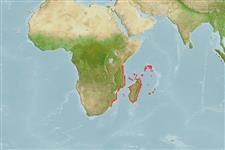Common names from other countries
>
Eupercaria/misc (Various families in series Eupercaria) >
Lutjanidae (Snappers) > Lutjaninae
Etymology: Lutjanus: Malay, ikan lutjan, name of a fish.
More on author: Cuvier.
Environment: milieu / climate zone / depth range / distribution range
Ökologie
seewasser riff-verbunden; tiefenbereich 10 - 50 m. Tropical; 4°S - 30°S, 30°E - 59°E (Ref. 55)
Western Indian Ocean: Mozambique, Natal in South Africa, Madagascar, Réunion and Mauritius.
Size / Gewicht / Alter
Maturity: Lm ? range ? - ? cm
Max length : 25.0 cm TL Männchen/unbestimmt; (Ref. 55); common length : 20.0 cm TL Männchen/unbestimmt; (Ref. 55)
Rückenflossenstacheln (insgesamt) : 11 - 12; Rückenflossenweichstrahlen (insgesamt) : 12 - 13; Afterflossenstacheln: 3; Afterflossenweichstrahlen: 7 - 8. Dorsal profile of head steeply sloped. Preorbital width usually less than eye diameter. Preopercular notch and knob well developed. Scale rows on back rising obliquely above lateral line. Brownish dorsally, grading to yellowish-white ventrally, with a series of 6 narrow blue stripes. A blackish spot is usually present on the lateral line below the anterior portion of the soft dorsal fin rays.
Adults inhabit coral reefs where they occur usually solitarily or in small groups of about 5 to 10 individuals. They feed on fish and crustaceans (Ref. 5213).
Life cycle and mating behavior
Maturities | Fortpflanzung | Spawnings | Egg(s) | Fecundities | Larven
Allen, G.R., 1985. FAO Species Catalogue. Vol. 6. Snappers of the world. An annotated and illustrated catalogue of lutjanid species known to date. FAO Fish. Synop. 125(6):208 p. Rome: FAO. (Ref. 55)
IUCN Rote Liste Status (Ref. 130435)
CITES (Ref. 128078)
Not Evaluated
Bedrohung für Menschen
Harmless
Nutzung durch Menschen
Fischereien: kommerziell
Tools
Zusatzinformationen
Download XML
Internet Quellen
Estimates based on models
Preferred temperature (Ref.
115969): 24 - 27.6, mean 26.2 (based on 44 cells).
Phylogenetic diversity index (Ref.
82804): PD
50 = 0.5000 [Uniqueness, from 0.5 = low to 2.0 = high].
Bayesian length-weight: a=0.01479 (0.00706 - 0.03101), b=2.97 (2.81 - 3.13), in cm Total Length, based on LWR estimates for this Genus-body shape (Ref.
93245).
Trophic level (Ref.
69278): 4.0 ±0.66 se; based on food items.
Widerstandsfähigkeit (Ref.
120179): hoch, Verdopplung der Population dauert weniger als 15 Monate. (Preliminary K or Fecundity.).
Fishing Vulnerability (Ref.
59153): Low vulnerability (15 of 100).
